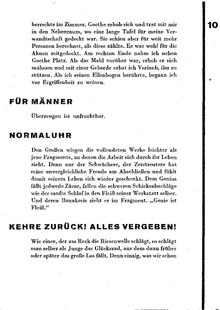One-way street (book)
Einbahnstraße is a philosophical-literary work by Walter Benjamin , which first appeared in 1928 by Rowohlt Verlag . The collection of short texts, which only comprises around 80 printed pages, is best known for its many aphoristic formulations. It is the only literary work Benjamin published during his lifetime, and alongside the essay The Work of Art in the Age of Technical Reproducibility from 1935, it is probably his best-known work. The work has been in the public domain since 2011 .
History of appearance
The first edition of One-Way Street was not published as a book in 1928, but as a brochure with a cover designed by Russian photographer Sasha Stone .
Literary form
One-way street is notable above all for its unusual shape: the book contains over 100 short, sometimes seemingly fragmentary literary miniatures that seem to follow one another in an incoherent manner. These include dream logs and memories, sentences and apercus , theses, travelogues , portraits , still lifes and sketches. Some texts are also similar to diary entries . The individual contributions can hardly be grouped under one literary genre, but because of their many concise formulations ("Gifts must affect the recipient so deeply that he is startled"), one-way street was often assigned to aphorism . Benjamin himself later coined the term "thought pictures" for his form of literary-philosophical miniature, in a contribution in Kindler's Literature Lexicon , Benjamin's literary process was also interpreted as allegorizing .
Divided is one way through numerous intermediate and sub-headings that partially absorb the language of contemporary leaflets, posters or signs ( "These plantings are recommended to the protection of the public", "Caution stage!"), Goods ( "gloves", "standard clock") or places of contemporary urban life ("gas station", "breakfast room", "civil engineering", "hairdresser for meticulous ladies", "postage stamp shop"). The subtitles are often in a - sometimes somewhat puzzling - tension relationship with the text sections that follow them. Some paragraphs are preceded by mottos or quotations from other authors.
A clear order in the order of the individual contributions is not recognizable. Kindler's New Literature Lexicon therefore sees similarities to the treatise in the external form of the one-way street , and the relationship with surrealist assembly processes was also noted in contemporary reception .
The typography and design of the first edition of One-Way Street clearly shows the influences of Bauhaus and Constructivism , which were considered modern styles during the Weimar Republic .
subjects
The topics that are dealt with in the one-way street include the relationship between men and women, the consequences of the capitalist social order , childhood memories, German inflation and its consequences as well as 19th century civil society. The best-known sections of One-Way Street include articles on literary criticism , poetics and the role of the writer such as "The writer's technique in 13 theses", "The critic's technique in 13 theses" and the humorous listicle "No. 13", the books with Compares prostitutes ("I. You can take books and prostitutes to bed").
effect
Although One-Way Street did not generate a strong or unanimously positive response when it appeared, its - for the conditions at the time - unusual shape proved to be momentous. The book can be seen as a formal model for Theodor W. Adorno's Minima Moralia (1951) and Ernst Bloch's traces (1930). Both authors were friends with Benjamin.
continuation
By the mid-thirties Benjamin put together a "list of additions to the one-way street" that comprised 43 texts. It is printed among other things in the critical complete edition of Benjamin's works.
Quotes on one-way street
- Theodor W. Adorno : "The technique of the 'one-way street' is related to that of the player. This is not least of all the shocking aspect of the book."
- Ernst Bloch : "This style of speech has the wealth of intellectual couplings that of Max Ernst and Jean Cocteau to Surrealism makes the coupling of There and next here of breeding myths with the exaktesten everyday.."
Expenses (selection)
- One way street. Rowohlt Berlin 1928. (First and only edition during his lifetime, no ISBN)
- One way street. Suhrkamp Berlin 2001. ISBN 978-3-518-01027-3 .
- Volume 8: one-way street . In the series: works and estate. Critical complete edition . Edited by Detlev Schöttker with the assistance of Steffen Haug. Suhrkamp Berlin 2009, ISBN 978-3-518-58524-5 .
Web links
Remarks
- ↑ a b Heinz L. Arnold (ed.): Kindlers Literatur Lexikon . 3. Edition. Metzler, Stuttgart 2009.
- ^ Stiftung Deutsches Historisches Museum: Just seen on LeMO: LeMO Chapter: Weimar Republic. Retrieved January 11, 2019 .
- ^ Stiftung Deutsches Historisches Museum: Just seen on LeMO: LeMO Chapter: Weimar Republic. Retrieved January 11, 2019 .
- ^ Walter Benjamin: One-way street. Works and Estate. Critical Complete Edition, Volume 8. Retrieved January 11, 2019 .

